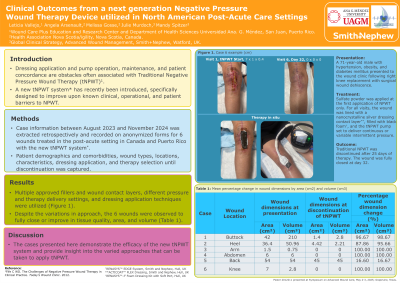Practice Innovations
(PI-045) Clinical Outcomes from a Next Generation Negative Pressure Wound Therapy Device Utilized in North American Post-acute Care Settings
Friday, May 2, 2025
7:45 PM - 8:45 PM East Coast USA Time

Angela Arsenault, RN, BN, IIWCC-CAN, MN, NP; Melissa Gosse, RN, BN, IIWCC-CAN, MSc; Julie Murdoch, PhD; Mandy Spitzer, MBA, RN, CWOCN, CFCN
Introduction: Negative pressure wound therapy (NPWT) is a wound treatment modality indicated for acute and chronic wounds, most often utilized to expedite the healing process of large and/or highly exuding wounds1. Complex dressing application and pump operation, maintenance, and patient concordance with therapy are obstacles often associated with NPWT. A new traditional NPWT (tNPWT) has recently been introduced, specifically designed to improve upon known clinical, operational, and patient barriers to NPWT2.
Methods: Case information was extracted retrospectively and recorded on anonymized forms. Patient demographics and comorbidities, wound types, locations, characteristics, dressing application, and therapy selection until discontinuation was captured. Cases were captured on 6 patients exhibiting 13 wounds treated with NPWT between August 2023 and September 2024 in North America.
Results: The NPWT system was applied to wounds classified as a pressure injury or post-surgical wound. The wounds presented in different anatomical locations, and the patient demographics, comorbidities, levels of chronicity, and durations of therapy varied between all patients. Multiple approved fillers and wound contact layers, different pressure and therapy delivery settings, and dressing application techniques were utilized. Despite the variations in approach, the 13 wounds were observed to fully close or improve in tissue quality, area, and volume.
Discussion: The new pump was designed to improve access to and clinician and patient acceptance of tNPWT. The cases presented here demonstrate the efficacy of the new tNPWT pump and provide insight into the varied approaches that can be taken in the application of tNPWT.
Methods: Case information was extracted retrospectively and recorded on anonymized forms. Patient demographics and comorbidities, wound types, locations, characteristics, dressing application, and therapy selection until discontinuation was captured. Cases were captured on 6 patients exhibiting 13 wounds treated with NPWT between August 2023 and September 2024 in North America.
Results: The NPWT system was applied to wounds classified as a pressure injury or post-surgical wound. The wounds presented in different anatomical locations, and the patient demographics, comorbidities, levels of chronicity, and durations of therapy varied between all patients. Multiple approved fillers and wound contact layers, different pressure and therapy delivery settings, and dressing application techniques were utilized. Despite the variations in approach, the 13 wounds were observed to fully close or improve in tissue quality, area, and volume.
Discussion: The new pump was designed to improve access to and clinician and patient acceptance of tNPWT. The cases presented here demonstrate the efficacy of the new tNPWT pump and provide insight into the varied approaches that can be taken in the application of tNPWT.

.jpg)